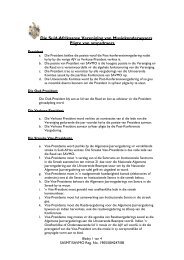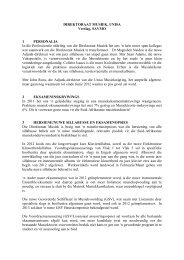2006 Edition 2 (Issue 144) - Sasmt-savmo.org.za
2006 Edition 2 (Issue 144) - Sasmt-savmo.org.za
2006 Edition 2 (Issue 144) - Sasmt-savmo.org.za
Create successful ePaper yourself
Turn your PDF publications into a flip-book with our unique Google optimized e-Paper software.
The next stage was to see what happened when another<br />
29 assessors were asked to use C1-C12 to judge performances.<br />
This time, the video recording consisted of a series<br />
of ten solo performances, each on a different instrument.<br />
There were two groups of assessors:<br />
Group 1: Twelve music teachers and student teachers<br />
specializing in music<br />
Group 2: Seventeen student teachers specializing in subjects<br />
other than music<br />
Some members of this group had shown interest in<br />
music through, for example, joining their college<br />
choir. But none had studied music at school beyond<br />
the age of 16, or taken instrumental lessons since<br />
leaving school.<br />
The assessors were asked to imagine that each performance<br />
was part of a Grade 8 examination, and to assess the<br />
performance as seen and heard without making any allowances,<br />
for example for performers who looked younger.<br />
For each performance there was a double-sided sheet to<br />
be completed. On the first side, the assessor gave a single<br />
mark of up to 30 using the Associated Board of the Royal<br />
Schools of Music’s criterion-referenced classification system<br />
(distinction, merit, pass, and fail) as a guide. On the<br />
second side, the assessor rated the performance on each of<br />
the twelve bipolar constructs using a four-point scale.<br />
The marks given by individuals for performances were converted<br />
into ranks, with the performance given the highest<br />
mark being assigned a rank of one. The constructs were<br />
scored from one to four according to their placing on the<br />
four-point scale. There was a positive correlation between<br />
each of the constructs and the overall rank ranging from r<br />
= 0.4 (C6) to r = 0.7 (C10 and C11) (n = 290). 5 I followed<br />
this up with another statistical technique: multiple regression<br />
analysis. 6 This showed that the constructs accounted<br />
for more than two-thirds of the variance in the ranking<br />
of the performances, for both Group 1 and Group 2. This<br />
indicates that the holistic assessment could be accounted<br />
for in terms of common constructs to a substantial extent.<br />
It is interesting that there is so little difference in the results<br />
for Groups 1 and 2, i.e. that there is little apparent difference<br />
in the holistic assessment according to the extent of<br />
formal musical expertise. This offers tentative support to<br />
the theory that the reliability of holistic assessment stems,<br />
at least partly, from practice in every situation.<br />
We have seen that holistic assessment has advantages over<br />
segmented assessment. It is more musically credible, in<br />
the sense that it is more like assessment made of musical<br />
performance in the real world. In addition, it can be more<br />
reliable, and no more subjective.<br />
This discussion has been possible only because there is<br />
some general understanding of what is meant by ‘performer’<br />
and ‘performance’. We have some idea of what assessment<br />
systems in this field are trying to predict. We can<br />
tell if the marks produced are nonsense.<br />
This is an unusual situation. Much educational assessment<br />
with an outcome of a single mark or grade takes place in<br />
a less certain context. We may know what a performer is,<br />
but do we know what a musician is? Yet we routinely combine<br />
marks obtained for listening, composing, and performing<br />
to give a music GCSE, or A level grade. Is there an<br />
understanding of what a mathematician or a scientist is?<br />
Yet we combine marks to give single grades also in these<br />
subjects.<br />
It is sometimes argued that there is something particularly<br />
difficult about assessment in the arts. Might it not be that<br />
some areas of the arts offer opportunities for particularly<br />
rigorous assessment? If we understand what behaviour<br />
we are trying to measure, then we can tell if the marks<br />
we obtain are sensible. Perhaps those who devise summative<br />
assessment systems for non-arts subjects could learn<br />
something from looking at aspects of the arts.<br />
BIBLIOGRAPHY AND FURTHER READING<br />
FISKE, M. 1977. Relationship of Selected Factors in Trumpet<br />
Performance Adjudication Reliability. Journal of<br />
Research in Music Education. 25(4):256-263<br />
KELLY, G. 1955. The Psychology of Personal Constructs.<br />
New York: Norton.<br />
MILLS, J. 1991. Assessing Musical Performance Musically.<br />
Educational Studies. 17(2):173-181.<br />
MILLS, J. 2005. Music in the School. Oxford: Oxford University<br />
Press.<br />
Reproduced from Music in the School by permission of<br />
Oxford University Press (www.oup.com).<br />
ISBN 0-19-322300-7<br />
Janet Mills is a Research Fellow at the Royal College of Music, London.<br />
She began her career as a secondary school music teacher,<br />
and was a teacher trainer prior to working for<br />
ten years as an HM inspector of Schools. She<br />
works widely in schools, universities and the<br />
community. Her writing includes Music in the<br />
School (OUP 2005), Music in the Primary School<br />
(CUP 2001) and many research articles.<br />
1.<br />
2.<br />
3.<br />
4.<br />
5.<br />
6.<br />
See Mills 2005:156<br />
Fiske 1977<br />
Mills 1991<br />
Kelly 1955<br />
Correlation coefficients (denoted r) can range from 1 (perfect<br />
positive correlation) to 0 (no correlation) to -1 (perfect negative<br />
correlation). So the marks that assessors gave the performance<br />
were influenced most by whether the performance was<br />
clean or sensitive, and least by whether they thought that the<br />
tempo was appropriate.<br />
The multiple regression analysis searched for values a1 to a12<br />
such that a ‘regression’ equation of the form:<br />
Rank = a1C1 + a2C2 +a3C3 + … + a12C12<br />
accounts for as much as possible of the variance in ranks, when<br />
calculated across the 29 x 10 = 290 performances heard. The<br />
regression equation that was calculated here accounts for<br />
71% (n = 290) of the variance in the ranks. The separate figures<br />
for Groups 1 and 2 are 73% (n = 120) and 69% (n = 170)<br />
respectively.<br />
Suid-Afrikaanse Musiek Onderwyser |<strong>144</strong> | November <strong>2006</strong>




